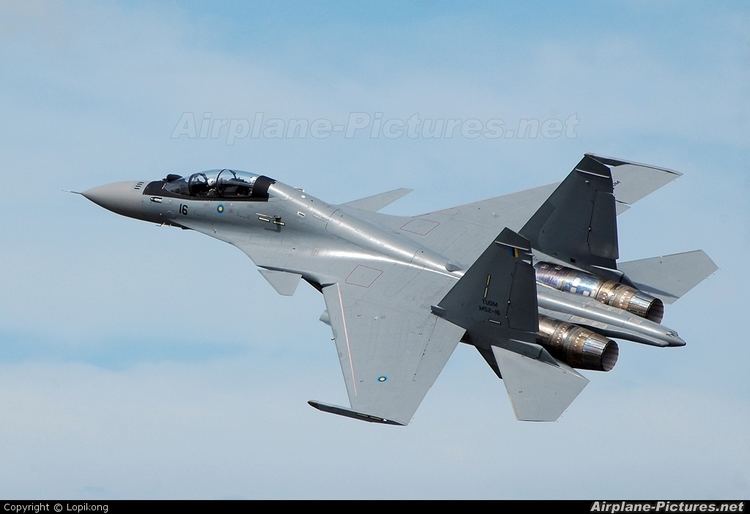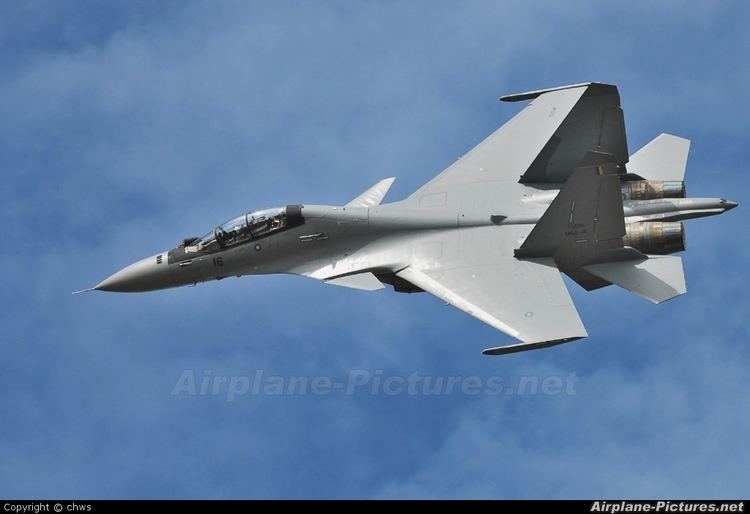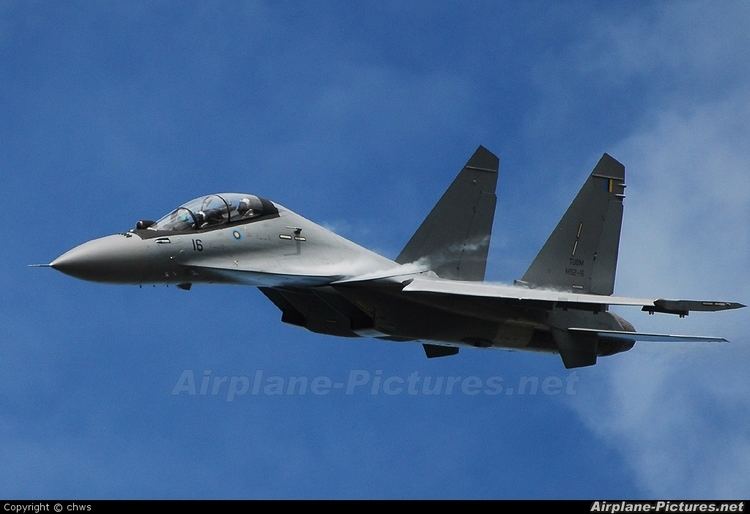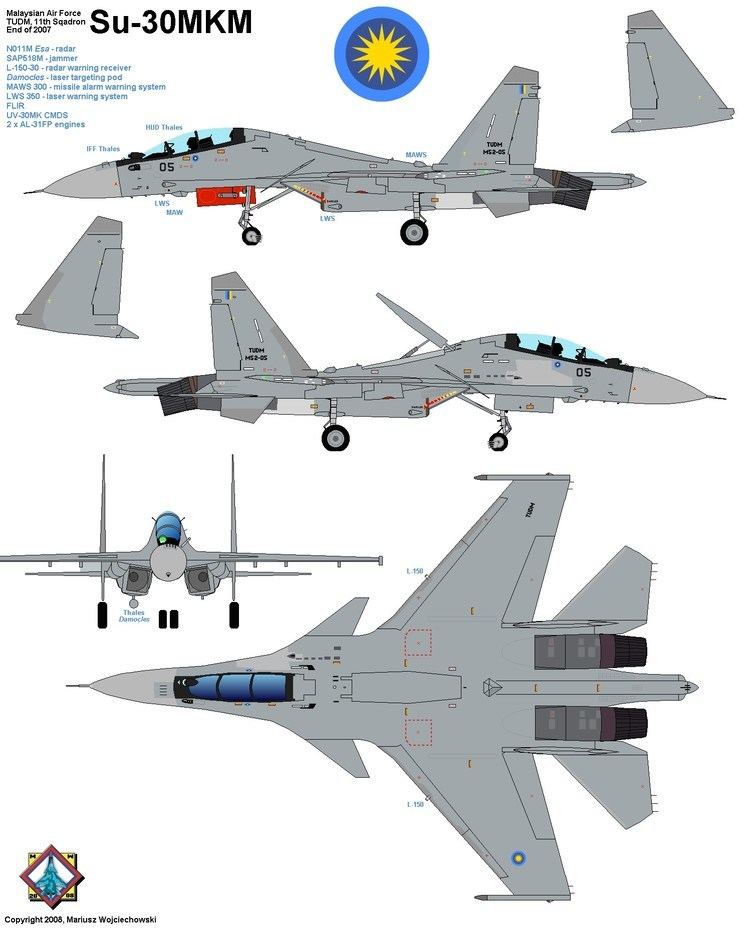Weight 18,400 kg Length 22 m Engine type Saturn AL-31 | Wingspan 15 m Unit cost 35,000,000–53,000,000 USD | |
 | ||
The Sukhoi Su-30MKM (Modernizirovannyi Kommercheskiy Malaysia – Modernized Export Malaysia) is a supermaneuverable fighter of the Royal Malaysian Air Force. It is a variant of the Su-30 series fighters, with many significant improvements over the original Su-30MK export version. The Su-30MKM was developed by the Sukhoi Design Bureau and is based on the Su-30MKI of the Indian Air Force. Both aircraft have common airframe, thrust vectoring engines and digital fly-by-wire system, However the MKM version differs from the MKI mainly in the composition of the onboard avionics. It can carry up to 8,000 kg/ 17,650 lb of weapons and payloads over 700 nmi unrefueled combat radius.
Contents

In 2003, the Su-30MKM was selected by the Royal Malaysian Air Force (RMAF). In August 2003, during the course of President Vladimir Putin’s official visit to Malaysia, the contract for the Su-30MKM aircraft was signed. Except for Russian MiG-29s, the RMAF has previously operated aircraft of Western origin. At the time of delivery the Su-30MKMs were the most advanced and heavy fighters in Southeast Asia.

Development

In 2003, Malaysia committed to purchase 18 Su-30MKMs. As part of the contract, Russia sent the first Malaysian cosmonaut to the International Space Station. It was a project under the government-to-government offset agreement through the purchase of Su-30MKM fighter jets for the Royal Malaysian Air Force. Under this agreement the Russian Federation bore the cost of training two Malaysians for space travel and for sending one to the International Space Station (ISS) in October 2007 under the Angkasawan program.

In August 2003, Malaysia signed a US$900 million contract with Irkut Corporation for 18 Sukhoi Su-30MKMs. Malaysia operates the F/A-18D Hornet, and was offered Boeing's F/A-18E/F Super Hornet, but chose the Su-30MKM. The Su-30MKM is an advanced variant, whose performance involves considerable improvements over Su-30MK/MKK fighters. Irkut Corporation subcontracted the task of manufacturing the canards, stabilizers and fins to HAL Nasik.
The first two aircraft were handed over to the RMAF on May 2007 at Irkut's aircraft manufacturing facility at Irkutsk, Russia. The two aircraft were later delivered to RMAF Gong Kedak, Malaysia on June 2007 by an An-124-100. By December 2007, seven months after the delivery of the first two aircraft, the RMAF had taken delivery of six Su-30MKMs. The eighteenth and last aircraft arrived at RMAF Gong Kedak on August 2009 with the three other aircraft of its batch.
The Su-30MKMs carry serial numbers M52-01 to M52-18, ascending by order of delivery.
Design
The Su-30MKM was developed by the Sukhoi Design Bureau and is based on the Su-30MKI. The aircraft has the same airframe, same engines with thrust vector control (TVC), and an advanced digital fly-by-wire system. The MKM version differs from the MKI mainly in the composition of the onboard avionics. Thales supplies the Head-up display (HUD), navigational forward-looking IR system NAVFLIR and the Damocles targeting pod. The aircraft carries missile approach warning sensor (MAWS) and laser warning sensor (LWS) manufactured by Avitronics (South Africa). It can carry up to 8,000 kg/ 17,650 lb of weapons and payloads over 700 nmi unrefueled combat radius.
The Su-30MKM can legitimately claim super-maneuverability via digital fly-by-wire, canards, and two Saturn AL-31FP engines with thrust vectoring producing 27,500 lb thrust each with afterburners. This gives them an edge in close-in fights, allowing the pilot to rapidly point the plane at potential targets to draw them within the AA-11/R-73 Archer’s wide infrared seeker cone, then launch and quickly change energy state and direction.
The electronic warfare (EW) systems, phased array radars, optical-location systems with laser rangefinder were all produced by leading Russian manufacturers. At that time, officers from RMAF formed a Su-30MKM Project Team which was based in Moscow; the team had actively participated in the integration of all the avionics systems. The aircraft is capable of conducting SEAD mission when equipped with two KNIRTI SAP-518 jamming pods and Kh-31P anti-radiation missiles. The KNIRTI SAP-518 covers NATO surface-to-air and air-to-air threats in the G-J bands. It is equipped with NIIP N011M phased array radar for long range aerial combat which can track up to 15 targets and engage 4 targets simultaneously. It can also be equipped with a Thales Damocles Laser Designation Pod (Thales) surveillance & targeting pod for precision ground attack. It has a rear-facing radar, HUD (Thales), NAVFLIR (Navigation Forward Looking Infra-red) (French). Missile Approaches Warning System (MAWS) & laser warning sensor (LWS) supplied by Saab Avitronics of South Africa.
Operators
Specifications (Su-30MKM)
Data from Irkut Corporation, and Sukhoi
General characteristics
Performance
Armament
Avionics
